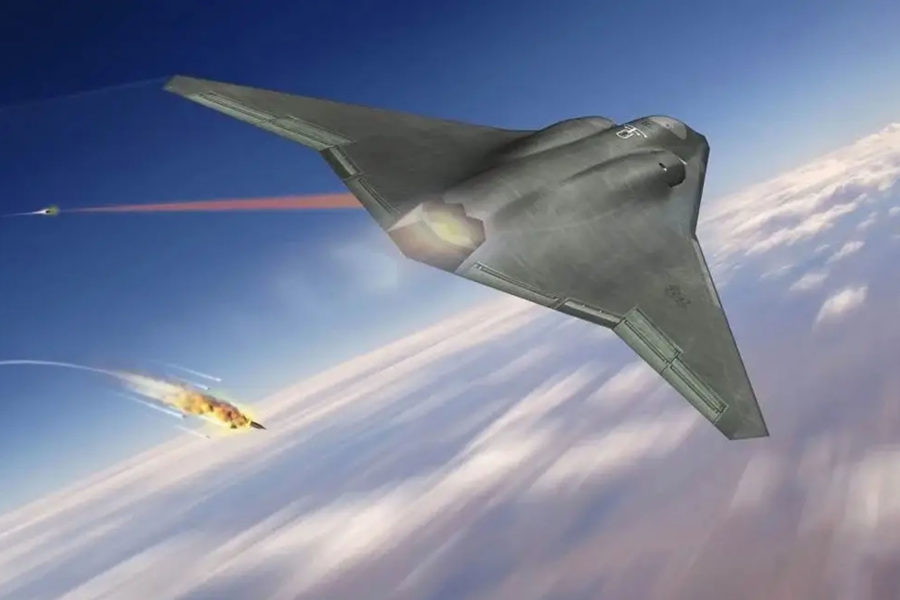House and Senate lawmakers, in their recently unveiled compromise 2024 National Defense Authorization Act, are seeking tight oversight of both the Air Force and the Navy on their respective versions of the new and highly secret Next Generation Air Dominance fighter and the Collaborative Combat Aircraft programs
Specifically, lawmakers are demanding briefs every six months on virtually all metrics of the projects.
NGAD is a term used by both the Air Force and Navy to describe their future crewed stealthy air dominance aircraft; in the Air Force, the NGAD will succeed the F-22 and is described as a “family of systems” to include offboard sensors and accompanying aircraft. CCAs are uncrewed, autonomous aircraft that will accompany and fight alongside crewed aircraft, performing missions such as electronic warfare, defense suppression, or as carriers of additional weapons.
Though similarly named, the Air Force and Navy/Marine Corps NGADs and CCAs are not joint programs like the F-35, although program officials have said they are sharing information and coordinating as the projects develop.
In reporting language attached to the NDAA, conferees said their provisions are aimed at program “accountability” for NGAD and CCAs. First, they want a baseline for the programs, and then “a matrix that identifies, in six-month increments, key milestones, development and testing events, and specific performance goals for the engineering manufacturing and development [EMD] phase … of the programs.”
The matrix would give the Technology Readiness Levels “of major components and subsystems” as well as “key demonstration and testing events.” A TRL identifies where a particular technology is on a scale of 1-9, with 1 being highly experimental and 9 being mission-proven in the field. In recent years, the Pentagon has demanded a TRL of 6 for most new capabilities to proceed to engineering manufacturing and development.
“Key demonstration and testing events” is likely a reference to milestones such as first major aircraft joins; first systems power-ons, first flights, etc.
Lawmakers also want regular updates on design and software maturity; subsystem and system-level integration maturity; manufacturing readiness levels for critical items; the status of manufacturing; “system verification, validation and key flight test events;” reliability; availability for flight operations, and maintainability.
Possibly more problematic for the services, the lawmakers specified a long list of items for which they want detailed, itemized costs. For some programs in recent years, Congress has directed the Pentagon to identify costs over the program’s entire service life—which could be more than 50 years. Such estimates are challenging, small variations can become quite large over times, and inflation estimates are scarcely more than a guess.
Nonetheless, every six months lawmakers want the service Secretaries to give their “cost position … on the total cost for … the EMD phase and low initial rate of production lots of the programs” and a matrix “expressing the total cost for the prime contractor’s estimate for such EMD phase and production lots, both of which shall be phased over the entire EMD period.”
Specific costs must be provided for:
- the air vehicle
- propulsion
- mission systems
- vehicle subsystems
- air vehicle software
- systems engineering
- program management
- system test and evaluation
- support and training systems
- contract fees
- engineering changes
- direct mission support
- government testing
- ancillary aircraft equipment
- initial spares
- contractor support
- modifications
The first update will be required six months after the Secretaries provide their initial reports, and these will represent the program baseline for EMD as well as low-rate initial production. Each update will have to explain progress made on the specific category, cost changes incurred, and the Pentagon Comptroller will have to sign off on these reports as accurate, with their assessment of cost, performance, and schedule “trends.”
Moreover, each Secretary is to define Key Performance Parameters (KPPs) for the NGAD and CCA for the “threshold and objective costs.” These KPPs are also to be stated for “each cost category” outlined in the language.
The services are also told to identify “the highest acceptable cost for that category” as well as “an objective value indicating the lowest cost expected to be achieved by that category.” Those costs are to be stated in various ways, including:
- Unit recurring flyaway cost
- Average procurement unit cost
- Gross/weapon system unit cost
- Aircraft cost-per-tail-per-year
- Aircraft cost-per-flight-hour
Air Force Secretary Frank Kendall announced in May that solicitations for NGAD have gone out, and that a single offeror will be selected in 2024 to build it. Operational capability is expected circa 2030. Kendall has voiced a somewhat shorter timeline for the initial version of CCAs to be in service, saying the first ones could be flying in 2028.
The Senate is expected to action on the NDAA in the next few days, and the House could pass it shortly thereafter, putting the defense policy bill on track to become law before January.
